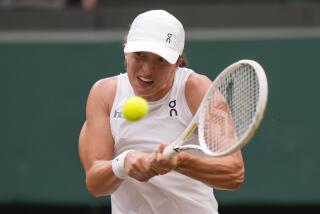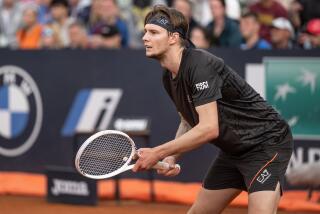Sampras, Hingis Alone at the Top
MELBOURNE, Australia â The making of history is seldom as thrilling as the retelling of it. Cases in point are the careers of tennis players Pete Sampras and Martina Hingis.
The two are so dominant that it appears only in hindsight will their achievements be fully appreciated. With another tennis season just beginning, each player will have a chance to cement his or her reputation.
For Sampras, history is about to be written. He has won 10 Grand Slam titles and this year could at least equal Roy Emersonâs record of 12. For the 16-year-old Hingis, history stretches in front of her, blank and waiting. Her three Grand Slam titles last season and her 75-5 record testify to the Swiss teenagerâs historical context.
At 26, Sampras is pulling down $15 million a year in prize money and endorsements and could be forgiven for letting up a little. He will, but not in his treasured Grand Slam events.
Tired and injured at the end of 1997, Sampras reaffirmed his priorities--winning Grand Slam titles. All else will take a back seat, including his participation in the Davis Cup. Expect Sampras to play fewer events and have fewer injuries in 1998.
Should Sampras repeat as the Australian Open champion, he has a chance to equal Emersonâs record at the French Open, the only Grand Slam title he has failed to win. A physically sound and focused Sampras cannot be denied.
The French Open was the only Grand Slam event Hingis didnât win last season. Only a fall off a horse and the ensuing five-week recovery stood between Hingis and a Grand Slam.
Few players were capable of stopping Hingis, who developed her clever game to include more power and more volleying.
Sampras and Hingis are the steady and dependable No. 1s, but the ranks are roiling with newcomers and fading former stars.
Ranked No. 3 and sinking is Michael Chang. His diligence and professionalism have sustained a career longer and on a higher level than most thought possible.
But it appears that what has been a plateau for Chang in recent years will now become a downward slope. Chang began 1997 on a hot streak--he won four titles and had a 28-4 record into April. The end of his season was less uplifting than his No. 3 ranking would suggest.
Chang took his loss to Patrick Rafter in the semifinals of the U.S. Open hard. Long in the shadow of Sampras, Chang understood that when Sampras, Andre Agassi and others fell away during the tournament, it was his best chance to add to his sole Grand Slam title (the French Open in 1989.) His failure to do so sent the usually optimistic Chang into a funk.
A poor showing at the Davis Cup final in Sweden put a dismal finish on a disappointing season. Chang has nothing left to change, no part of his game to improve, no mental weakness to bolster. Still only 25, Chang will have to consider accepting a lower ranking and the inevitability that other players will pass him.
Agassi, on the other hand, has made peace with such a scenario. Only a newfound humility has sustained the former No. 1âs prolonged comeback from injuries, distractions and a general performance slump.
Ranked No. 86 and trying to hang in, Agassi is still at that frustrating, on-again, off-again stage with his game. Inconsistency is dogging him and even within points it is possible for him to create an incredible shot alongside a clunker.
Patience will be Agassiâs best weapon this season if he is to continue his long climb back.
Another notable player who may not get back is Jim Courier. His work ethic is not enough to overcome an increasing number of injuries--he will sit out the Australian Open--and a style of play that grows ever more retro as the tour becomes more dynamic.
Last season was the most democratic ever on the menâs tour. Titles were spread among a wide spectrum of players. Three players made notable ranking leaps: Rafter went from No. 62 to No. 2, Jonas Bjorkman from No. 69 to No. 4 and Greg Rusedski from No. 48 to No. 6.
These playersâ ability to remain in the top 10 will be one of this seasonâs more interesting subplots. Of them, Rafter appears most likely to remain among the elite. His U.S. Open title--while greatly aided by upsets among seeded players--can hardly be seen as a fluke.
He defeated Rusedski in the final, and his fluid, all-court game appears to be more sustainable than the Englishmanâs, which requires his serve to be clicking.
Bjorkman was the hardest-working man in tennis last season and is now suggesting that heâs rethinking his commitment to playing so much. Bjorkmanâs schedule is crammed with singles, doubles and full Davis Cup participation.
Two perennial pretenders return, sort of. No. 5 Yevgeny Kafelnikov for the second year in a row will begin the season with an injury. The 1996 French Open champion broke a finger and missed three months last year. While preparing for the 1998 season, the Russian sprained his left knee and pulled out of the Australian Open.
Goran Ivanisevic has talent to burn and usually does. His 1997 season was so inconsistent that the Croatian dropped out of the top 10 for the first time in six years. He begins anew at No. 15, as talented as any player who has held that ranking.
Generally, itâs the womenâs tour that funnels a steady stream of teenagers to the professional ranks. Now the men have Lleyton Hewitt, the 16-year-old Australian high school student who last week became the lowest-ranked player ever to win an ATP Tour event.
Ranked No. 550, the hard-hitting Hewitt won the Australian Menâs Hardcourt Championships, defeating along the way, his idol, Agassi. After accepting his winnerâs check of $45,000, Hewitt announced he would not be returning to school, choosing instead to play the tour full time. His ranking moved to No. 200 after winning the title.
Of course, a 16-year-old is well into middle age by the standards of the womenâs tour, where âolderâ players are phasing themselves out in their early 20s.
Three newcomers stand out. Venus Williams became a Grand Slam finalist, losing to Hingis at the U.S. Open, but this will be the 17-year-oldâs first protracted year on the tour and her first with a reputation to defend.
She already has defeated Hingis this year and has shown maturity in her ability to filter out distractions. Even though Williams vows not to play more than three tournaments in a row, sheâll be a presence whenever she does play. Sheâs ranked No. 21 but has the ability to reach the top 10 and stay there.
Sibling rivalry hasnât yet set in, but 16-year-old Serena Williams is pressing the point. Venusâ younger and more fiery sister this week defeated No. 3 Lindsay Davenport, who has been playing well. Symbolically, Serena also defeated the tourâs other young star, Mirjana Lucic of Croatia: The two young players are poised on the brink of great things.
The problem for the women is not with players of the future. The womenâs tour has more established players in trouble than the men. Steffi Graf and Monica Seles are in deep trouble.
Graf still has not been able to return to acceptable form after major knee surgery last year. She wonât return until sheâs 100%, and only the lure of beating the Hingis is motivating the physically fragile Graf. Her ranking has plummeted to No. 28.
Selesâ fragility lies elsewhere. Her gravely ill father has become Selesâ top priority. The tour, however, is unsentimental and grinds on, leaving Seles behind.
Arantxa Sanchez Vicario is the female counterpart to Chang. Sheâs as good as sheâs ever going to get and canât work any harder. The gutty Spaniard is ranked No. 9, but like countrywoman Conchita Martinez, Sanchez Vicario probably will drop fast.
More to Read
Go beyond the scoreboard
Get the latest on L.A.'s teams in the daily Sports Report newsletter.
You may occasionally receive promotional content from the Los Angeles Times.











